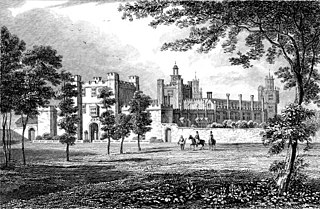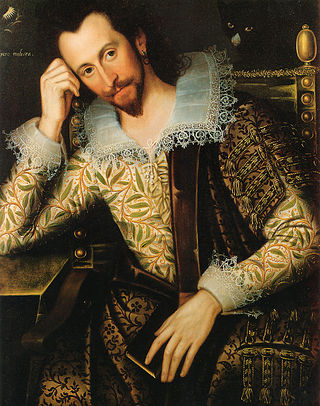
Theobalds House in the parish of Cheshunt in the English county of Hertfordshire, north of London, was a significant stately home and (later) royal palace of the 16th and early 17th centuries.

George Home, 1st Earl of Dunbar, KG, PC was, in the last decade of his life, the most prominent and most influential Scotsman in England. His work lay in the King's Household and in the control of the State Affairs of Scotland and he was the King's chief Scottish advisor. With the full backing and trust of King James he travelled regularly from London to Edinburgh via Berwick-upon-Tweed.
William Fowler was a Scottish poet or makar, writer, courtier and translator.

Worksop Manor is a Grade I listed 18th-century country house in Bassetlaw, Nottinghamshire. It stands in one of the four contiguous estates in the Dukeries area of Nottinghamshire. Traditionally, the Lord of the Manor of Worksop may assist a British monarch at his or her coronation by providing a glove and putting it on the monarch's right hand and supporting his or her right arm. Worksop Manor was the seat of the ancient Lords of Worksop.
Widdrington Castle is a Scheduled Ancient Monument and the site of a former medieval tower house and castle at Widdrington, Northumberland, England of which only earthworks now remain. The location is within a mile or so of the North Sea.
Patrick Gray, 6th Lord Gray, known most of his life as Patrick, Master of Gray, was a Scottish nobleman and politician during the reigns of Mary, Queen of Scots and James VI of Scotland.

Thomas Fowler was an English lawyer, diplomat, courtier, spy, servant of the Countess of Lennox, broker of the marriage of Mary, Queen of Scots and Lord Darnley, steward of the Earl of Leicester, advisor to James VI of Scotland and the Scottish ambassador in London, Archibald Douglas.

Frances Howard, Countess of Kildare, was a courtier and governess of Princess Elizabeth Stuart, Queen of Bohemia, and a member of the House of Howard.
Barbara Ruthven was a Scottish courtier and favourite of Anne of Denmark, expelled from court after the death of her brother.
Sir Francis Gofton was an English courtier and administrator. He was an auditor of royal accounts and jewels, Chief Auditor of the Imprest from 1597 and Auditor of Mint from August 1603. Gofton acquired the manor of Heathrow, and houses in Stockwell and West Ham. He was often called "Auditor Gofton". The surname is frequently transcribed as "Goston" or "Guston"
Richard Douglas was a Scottish landowner, courtier, and letter writer.
John Elphinstone of Selmes and Baberton (1553-1614) was a Scottish landowner and courtier.
Andrew Melville of Garvock was a Scottish courtier and servant of Mary, Queen of Scots.

Sir Thomas Griffin was an English landowner and hosted the royal family at Dingley.

Peter Saltonstall (1577-1651), was an English courtier and lawyer.
George More was an English supporter of Mary, Queen of Scots, and a participant in the Throckmorton Plot. A Catholic exiled in the Spanish Netherlands, he visited the royal court of Scotland in 1598.
Robert Wroth was an English courtier and Member of Parliament for Newtown.
John Crane was a soldier and comptroller of works at Berwick-upon-Tweed during the reigns of Elizabeth I and James VI and I.

Henry Mordaunt, 4th Baron Mordaunt was an English landowner involved in the Gunpowder Plot.

Nicholas Williamson was an English lawyer and Catholic recusant in the 1590s. He was arrested in 1595 after planning a visit to the court of James VI of Scotland. The Jesuit William Crichton had hoped that Williamson would encourage the ambition of James VI for the throne of England.









